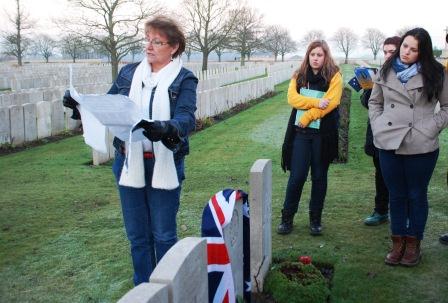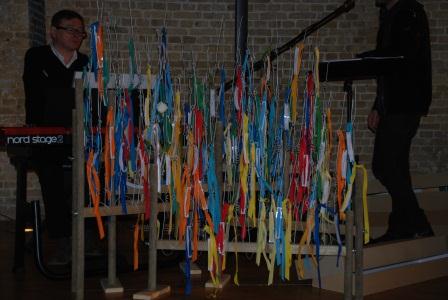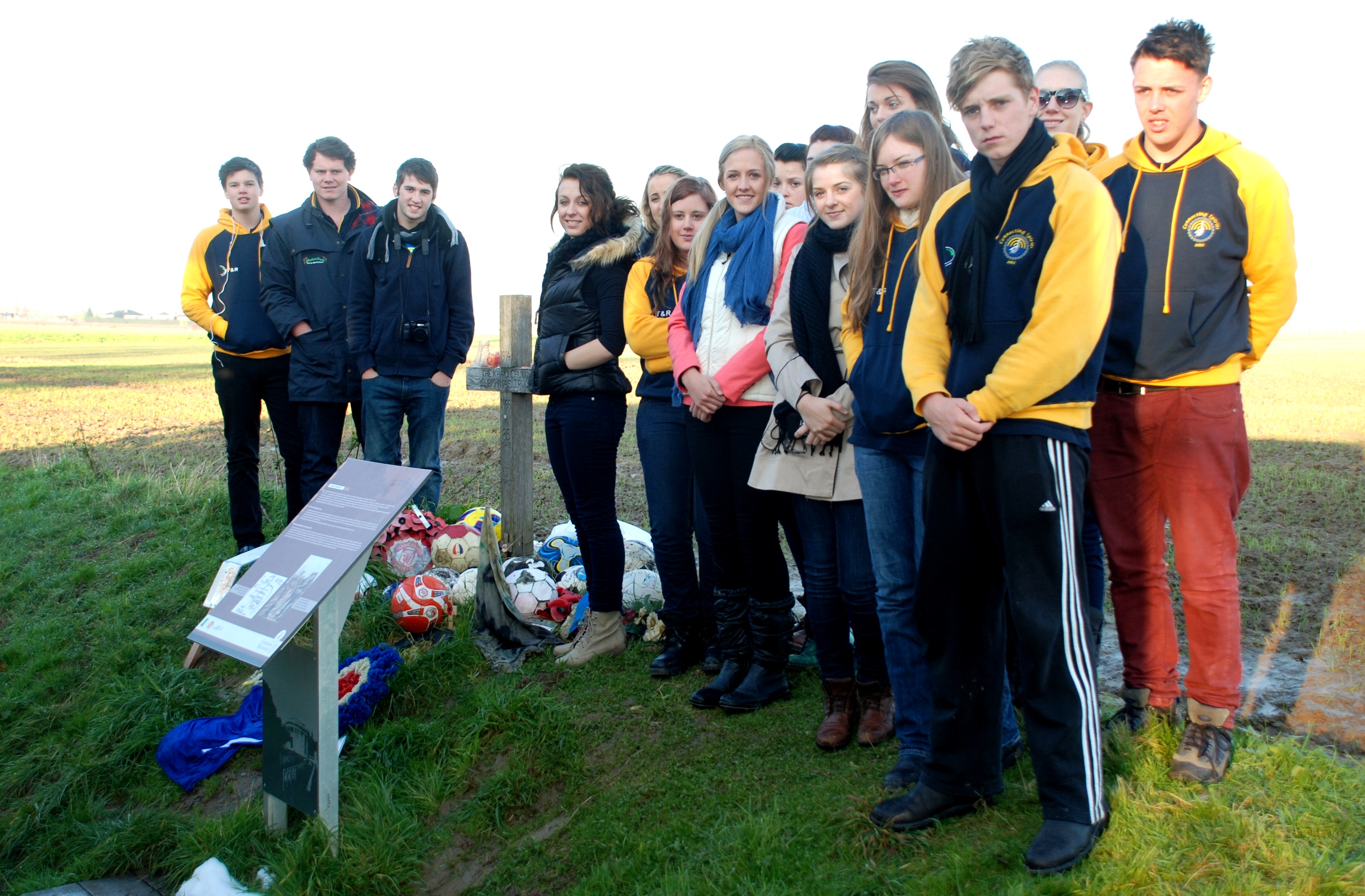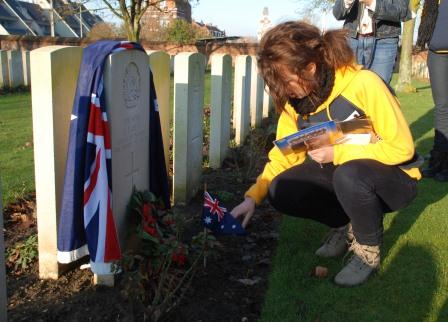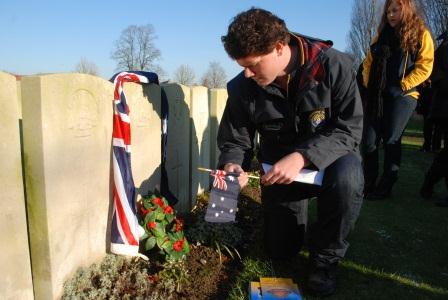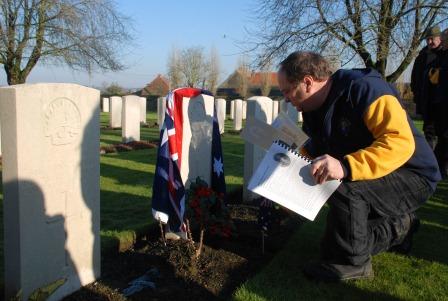8th December
Messines Area
The day started with a discussion between the coach driver and the guide about where we were going to first, and then changing their minds after 5 minutes. Added to that half of the roads in the area we were travelling through were blocked for upgrades and we needed to change our plans again. We ended up starting the day at the most famous site of the Christmas Truce of 1914, where German and English troops put aside their guns for a few hours and shared the spirit of the season, including playing soccer with each other and sharing Christmas treats. Unfortunately by the following Christmas as the fighting had intensified this was not likely to happen again.
We then made our way back into France where Tamika commemorated Garnet Francis Kelly in Armentieres and Mikey completed his last commemoration in Ballieul with Alfred Rowntree. We then returned to Belgium where I commemorated my Grandmother’s cousin in the cemetery at Kandahar Farm. From the distinctly piggy smell wafting across the cemetery, you knew that the former dressing station that gave the cemetery its name had reverted to being a farm. From here we visited another farm cemetery, at Le Plus Douve Farm where Julie commemorated her Dad’s cousin and one of his teachers from Prince Alfred College. The links that keep turning up as we delve deeper and deeper into this story never cease to astound. Judy Georgiou had decided to commemorate two Blackett soldiers and in doing so uncovered more information about Julie’s relative than she had known before. The two headstones were only metres apart. This cemetery has quite a number of 27th Battalion soldiers, mostly from South Australia and these were all killed before the great offensives of July 1916, while the Australian’s were posted to quite sectors to become accustomed to life in the trenches of the Western Front.
Then we made our way to Mud Corner Cemetery, which we had driven past earlier in the day, for Verity’s final commemoration. This required as to walk for about 500m down a muddy lane as the bus could not get to the entrance of the cemetery. We then wound our way past Messines to the Spranbroekmolen Crater which was one of the 19 mines detonated at the start of the battle of Messines on the 7th June 1917. Unlike the Lochnagar Crater, despite being of similar size, this one was full of water and is sometimes known as the Peace Pool. Julie used this place to start to tell of the book that she is about to publish to let younger people access the story of the Diggers.
The next commemoration was Jack’s at the Kemmel Chateau Cemetery of Cookes Plain boy, George Johnston Knight. Once again Jack used original letters from James to his family to add poignancy and emotion to the story he told.
Then to the town of Poperinghe for lunch, finally, before heading to Talbot House. This is a regular stop on our tours and once again proved to be an entertaining and informative respite from the battlefields. The chapel in the attic was particularly popular, and Marni showed a knack for reading from the Bible. Maybe a career move there, Marni!! It was then down to the kitchen for a cup of tea and to listen to Anne play the old piano once more..
Then to Lijssenthoek Military Cemetery for the last two commemorations of the day as Julie commemorated Birdwood boy Theodor Pflaum, and Anne commemorated Charles Lockhart. This cemetery is one of the largest in the area with over 10000 burials and they are all known graves, since this was a hospital burial ground. The burials are in date order so you can literally walk along a row and see each day pass. The number of consecutive days with burials is staggering with every day for almost three years represented. There have been some changes recently with an interpretive centre, and at the front there is a long line of steel posts each one representing a date, with notches to represent the number of burials for that day. This was quite moving to see as you could trace the major battles of the area as the number of notches markedly increased for a few days then slowly dropped away again. By this time the sun was setting over the headstones so we headed back to Ieper for tea. Then we headed out into the cold night air for a brisk walk to an old magazine that was the venue for a musical presentation by our friend Dries, who used to work at Talbot House. His show tells the story of one young officer for the 6 months that he was in the war. The narration is taken directly from this man’s letters back to his family is interwoven with music from the period. Dries stops every now and places pieces of wire each one representing a soldier from the battalion who has died in the intervening period of the story. Of course, the numbers are too high for Dries to do alone and so the audience is drawn in to interact with the story. Finally the day comes when the last piece of wire represents the young officer himself. This is a very moving story and mentions places that the group have seen and visited and so helps them to relate to it. A late night so back to the hotel and into bed for most of us. Rod had to go back to the Somme to pick up his passport as he needed to travel to England the following day and left it at home. So 4 am was bed time for Rodders!!!!
Jack Bricknell
Today was a special day for me. I finally got to commemorate my last soldier, George Johnston knight. When we arrived at the cemetery I was ready for my speech and felt confident that it was a respectful one to a very brave soldier. As I finished the commemoration i had mixed emotions. I was somewhere between sad and happy. Happy that this brave man Was not forgotten and that I got to remember him and sad because I feel that that would be the last time I would ever see his resting place again. As I sat on the bus driving away from his cemetery I thought "we'll there you go, a 25 year old farmer and 15 year old boy, both from little old Cookes Plains with nothing in common and nearly a century apart are both within two metres from each other and half way across the globe on Land that is foreign to them both."
Truly a memorable day that brings a tear to my eye as I write this.
Bianca Kahl
Seeing " I mourn for you dear son, no one may see me weep, But many a silent tear I shed when others are asleep" at the bottom of a young soldier's headstone I had a sudden realisation of the parents who had to watch their young ones go off to war and never see them return.
Anne Molinaro
Today I commemorated Charles Lockhart, days after commemorating his younger brother. I'm proud to have learnt their stories and told them to the people on this trip; neither of their memories will ever be forgotten.
Verity Schubert
The feeling that I felt during Edmund's commemoration is impossible to describe. It may have been because he was my last commemoration or because I have known him the longest. The music night was fantastic; I wish I could watch it again.
Lauren Bagshaw
It was really special to visit the site of the Christmas Truce. It is a most unbelievable example of how faith and tradition have the ability to bring people together.
The cemetery of Verity’s commemoration was certainly one of my favourites. It was tucked away at the bottom of a hill, a paddock separating it and another cemetery at the top; the sign said there were four down this road. You had to cross a bridge to get in with a steady stream of water beneath and at the back were trees almost protecting the resting souls. This cemetery was special because it entirely consisted of ANZAC soldiers. Here lied the brave and renowned boys from down under. The tranquillity of this cemetery gladdened me, for maybe, these souls could pretend they are home.
Our visit to Talbot House was really cool. The house had a more jovial atmosphere than the sombre war sites we had visited in recent days. The old piano in the glass room captured the essence of the lively spirit experienced here by the soldiers.














